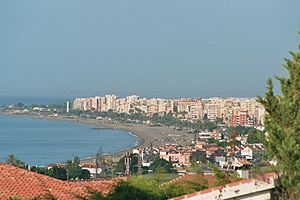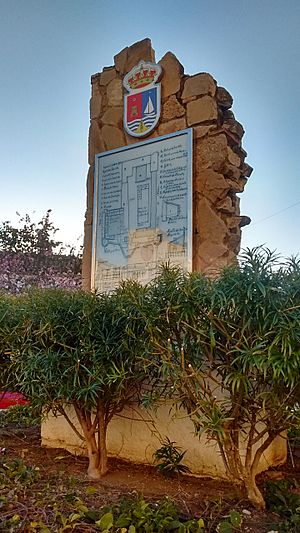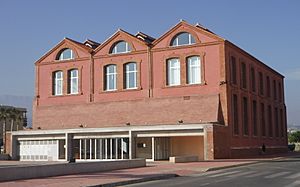Torre del Mar facts for kids
Torre del Mar is a sunny town on the southern coast of Spain. It's part of the larger area called Vélez-Málaga in the province of Málaga. Many Spanish families love to visit Torre del Mar for their summer holidays.
Contents
- Discovering Torre del Mar's Past
- Cool Places to See in Torre del Mar
- Torre del Mar Train Station
- Farmhouse Casa de la Viña
- Boat Club
- The Old Castle of Torre del Mar
- Entrance to the Hermitage of Las Angustias
- Home of the Virgin of La Victoria
- House of Larios, Torre del Mar
- Villa Mercedes
- Lighthouse on the Promenade
- Toré Toré Avenue Lighthouse
- The Sugar Factory of Torre del Mar
- Saint Andrew’s Parish Church
- La Casa Recreo (Tourist Office)
- See also
Discovering Torre del Mar's Past
Ancient Roots and Early Beginnings
Long ago, around the 7th century BC, people called the Phoenicians lived here. We know this because archaeologists found an old burial ground, or necropolis, at a place called Casa de la Viña. Later, a Roman city named Maenoba or Menoba stood near the Velez River. This city was famous for making and selling "garum," a special Roman fish sauce.
Even with these ancient roots, Torre del Mar as we know it today is quite new. It started in the early 1500s. A small castle from the Nasrid dynasty, called Alcozaiba Tower, protected the area. In 1487, the Catholic Monarchs took over and renamed it "Torre de la Mar," meaning "Tower of the Sea."
Castle Changes and Big Battles
During the 1500s and 1600s, the old Islamic castle was rebuilt. Then, in 1730, it was made even stronger. New parts were added to help it fight off attacks from the British navy.
In 1704, a huge naval battle happened off this coast. It was called the Battle of Velez-Málaga. French and Spanish ships fought against British and Dutch ships. Neither side won clearly, but many people were hurt.
Growing as a Town
Throughout the 1700s, more and more houses were built around the castle. A small neighborhood grew near the Casa de la Viña farmhouse. In 1748, a small church, called the Hermitage of Our Lady of Las Angustias, was also built.
Torre del Mar's economy relied on farming, fishing, and trade. The town had a large natural bay, which was great for ships. However, there wasn't a proper port, so goods had to be moved by small boats. Farmers exported many products like wines, raisins, and citrus fruits to northern Europe.
The Sugar Era
In the 1800s, sugar cane became very important. In 1796, José García Navarrete wanted to build a sugar mill. Later, in 1845, Ramón de la Sagra helped start a big sugar company. He built a modern sugar factory in 1846. But due to money problems, it was sold to the Larios family.
The Larios family ran the "Nuestra Señora del Carmen" sugar factory for 134 years. They were very powerful in the region. Sugar cane production started to slow down in 1988. In 1991, Torre del Mar had its last sugar harvest.
A Town with Its Own Council
For a short time, from 1842 to 1848, Torre del Mar even had its own town council! Records show that about 739 people lived in 174 houses then. The town had shops, a place for salting fish, a school, a church, and a cemetery. Some of the streets we see today, like Mar, Emmedio, and San Andrés, already existed back then.
New Roads and Trains
Around 1869, the road connecting Malaga to Almeria was built. This helped Torre del Mar grow closer to the sea. In the early 1900s, a train station was built. The first train arrived in 1908, but sadly, the train service stopped in 1968. The old train station is now the bus station.
Lighthouses Guiding the Way
Torre del Mar has had several lighthouses. One was built in the 1800s but was later destroyed. In 1930, a new lighthouse was built on what is now Toré Toré Avenue. It could shine its light up to 12 miles away! As the town grew, this lighthouse was closed. A new, taller lighthouse, 25 meters high, was built right next to the beach in 1976.
Tourism Takes Over
In the early 1900s, Torre del Mar started to attract visitors with spas. But it was in the second half of the century that tourism really boomed. Many more people came, and the town grew a lot. Tourism changed the town's look and even how people thought. Contact with European tourists brought new ideas to the Spanish people.
Cool Places to See in Torre del Mar
Torre del Mar Train Station
This old train station, built in 1904, looks very cool! It has a main building with two floors and two smaller sections on the sides. It's decorated with special brickwork around the doors and windows. The roofs have green glass tiles. This building used to be the train station for the line that went from Malaga to Velez-Málaga.
Farmhouse Casa de la Viña
This very old house stands at the foot of Monte de la Viña mountain. It's in the original part of Torre del Mar. People used to live here before moving closer to the old castle. The house is built around a square courtyard. It has different sections, including a three-story part and a long main front with barred windows.
Boat Club
The Boat Club building was designed by Francisco Estrada Romero. It has two floors and two main areas: one for people to relax and one for boats. The building's shape is interesting, with three different-sized circles and several rectangles. A glass tower shaped like an upside-down cone stands out. It was used to control boat races and lights. This building is a great example of modern design from the 1900s.
The Old Castle of Torre del Mar
This castle was the very first center of Torre del Mar. It was a small fort used to watch the coast and protect ships in the natural harbor. Over time, the land grew, and the castle ended up further from the sea. In 1730, it was rebuilt into the castle we see today. It had two walls and a central area for cannons.
The castle also had military buildings and storage rooms. It was used to store farm products like raisins, wine, and citrus fruits before they were shipped out. The castle is a very important symbol of Torre del Mar's history.
Entrance to the Hermitage of Las Angustias
Only the entrance is left of this old church. It was built in the 1700s but disappeared by the late 1800s. Houses now stand where the church once was. The entrance is made of stone slabs and has two tall pillars. It's a historical and artistic piece that reminds us of the old church that used to be here.
Home of the Virgin of La Victoria
The Larios family built this home around 1907. It was first called "The building of Ave Maria" and was used for charity. In 1936, it became a school and was renamed "Home of the Virgin of La Victoria." The building looks like hospitals from the late 1800s. It has two floors and a basement. Behind the main part, there are six parallel buildings connected by a hallway, with a garden in the middle. It has many large windows, making the rooms bright. This building is part of Torre del Mar's recent history and memories.
House of Larios, Torre del Mar
The Larios House was built in 1888 and was part of the sugar factory complex. It held the factory offices and the engineer's home. In the 1970s and 80s, a sugar cooperative used the building. It's a simple, practical building with a regional style. It has two floors and looks a lot like the factory building. You can see cool wooden decorations and glazed tiles. There's also a small entrance porch with iron poles and old tiles from Seville showing the Immaculate Conception.
Villa Mercedes
Located on Paseo Larios street, Villa Mercedes is a special house. It's the only regional-style house left from the late 1800s and early 1900s in this area. It has two floors and an attic, with a tower on the left side that looks like 16th-century towers. There's a porch with columns and cool plant designs. The main balcony and windows have decorative iron bars. This house is a great example of a vacation home for wealthy landowners from the industrial era.
Lighthouse on the Promenade
This lighthouse was built around the 1950s because the coast had moved further from the older lighthouse. It's built in an industrial style, with a square base and a tall rectangular body. It has windows and a top part where the light system was kept. The lighthouse is made of stone slabs. Inside, there's a spiral staircase to go to the top. Next to the tower is a small building that used to hold the electrical generator. This lighthouse shows how important fishing is to this town, which is so connected to the sea.
Toré Toré Avenue Lighthouse
This lighthouse was built in 1930, as you can see from the weather vane on top. It has an industrial style, with a square base and a tall rectangular body. It has windows, though the lower ones are now covered. The top part holds the light system. It's built with stone slabs, and the corners and windows are also edged with stone blocks. Inside, a spiral staircase goes up to the top. Next to the tower, there's a small building that used to house the electrical generator.
The Sugar Factory of Torre del Mar
Sugar production started in Torre del Mar around 1796. But it was in 1846 that a new, modern factory was built, using steam machines. Later, the Larios family took over the factory and named it "Factory of Nuestra Señora del Carmen." The factory made sugar until 1991. It was a huge part of the town's growth for many years.
In 1993, the main building of the factory was restored. You can visit it today for cultural events. Near it, you can still see two original chimneys and some restored machinery that was used to make sugar.
Saint Andrew’s Parish Church
As Torre del Mar grew in the late 1960s, the old church became too small. So, a new, bigger church was built. The new church has a modern design. It's very simple and open inside, with no columns blocking the view of the altar. This was possible because of new ways to build with concrete.
The church focuses on simplicity. The figures of Jesus Christ and the Virgin Mary are clear and central. The large statue of Jesus on the cross was made by a famous religious artist, Francisco Buiza Fernández.
La Casa Recreo (Tourist Office)
This old house from the 1800s was once a fancy home. Today, it's been updated and is now the Tourist Office. It has two floors and a garden in front. An original gallery inside was saved during the renovation.
On the ground floor, you'll find exhibitions and a help desk for tourists. The upper floor holds the tourism department offices. There's a glass-covered patio in the center of the building. Large wooden windows are a special feature. From the upper floor, you can see the promenade and the sea. This building reminds us of the beautiful homes where wealthy people used to relax on weekends and in summer.
See also
 In Spanish: Torre del Mar para niños
In Spanish: Torre del Mar para niños




